MSR (Mars Sample Return)
Non-EO
ESA
NASA
Exploration
Quick facts
Overview
| Mission type | Non-EO |
| Agency | ESA, NASA |
MSR (Mars Sample Return) Mission
October 14, 2020: Airbus has been selected by the European Space Agency (ESA) as prime contractor for the Mars Sample Return’s Earth Return Orbiter (ERO) – the first ever spacecraft to bring samples back to Earth from Mars. Mars Sample Return (MSR) is a joint ESA-NASA campaign and the next step in the exploration of Mars. ERO and the Sample Fetch Rover (SFR) are the two main European elements of MSR, both are set to be designed and built by Airbus. A manipulating arm, referred to as the Sample Transfer Arm (STA), that will transfer the samples from the SFR to the Mars Ascent Vehicle (MAV), is the third European contribution to the MSR program. The value of the ERO contract is € 491 million. 1)
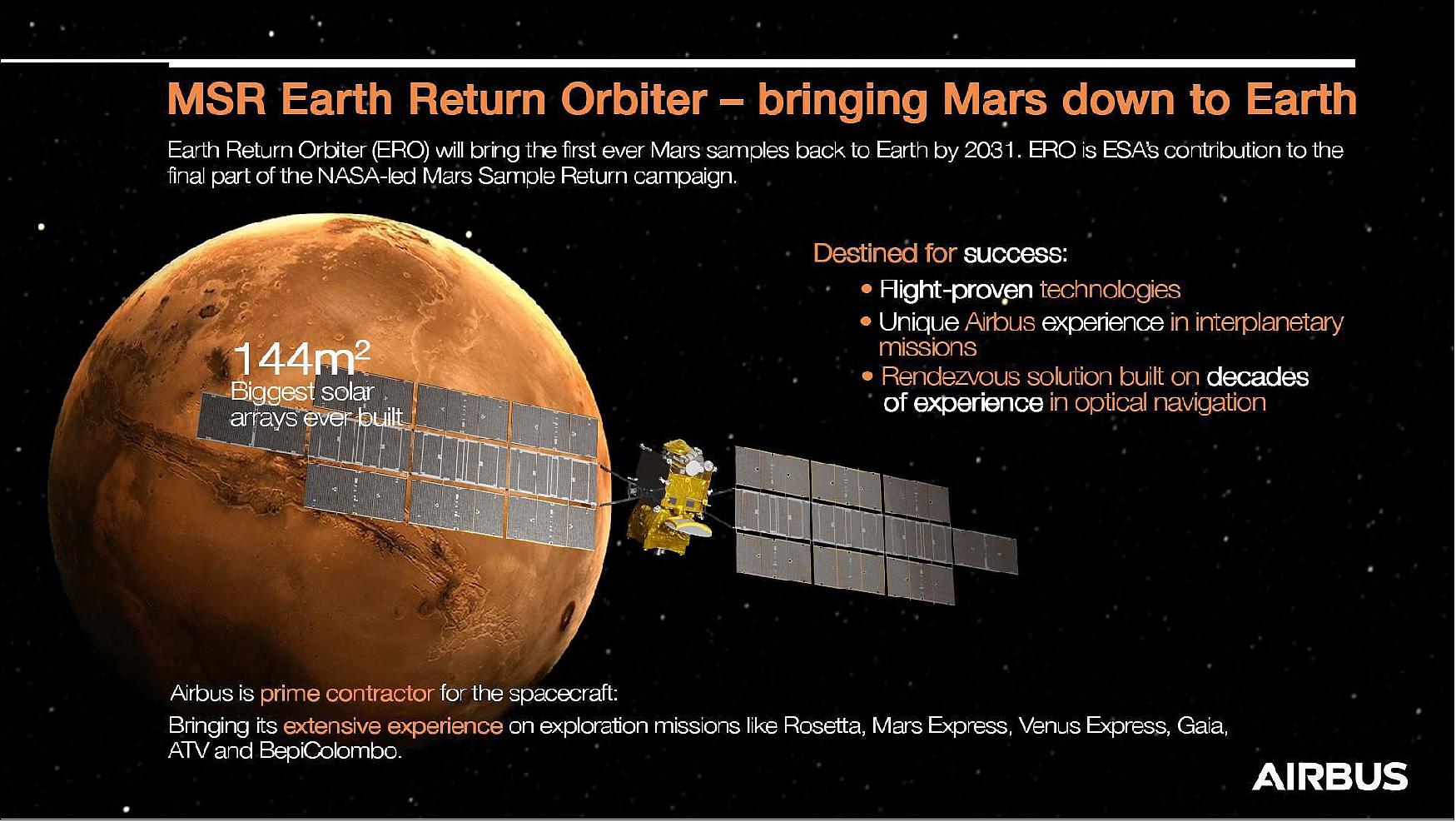
The five year mission will see the spacecraft head to Mars, act as a communication relay with the surface missions, perform a rendezvous with the orbiting samples and bring them safely back to Earth. Prior to launch from the Mars surface onboard the MAV, the Martian samples will be stored in sample tubes and collected by the SFR, for which Airbus has already commenced the study phase.
For ERO, Airbus will use its autonomous rendezvous and docking expertise built up over decades of experience in optical navigation, using technologies from the successful ATV (Automated Transfer Vehicle) and recent developments from JUICE, Europe’s first mission to Jupiter.
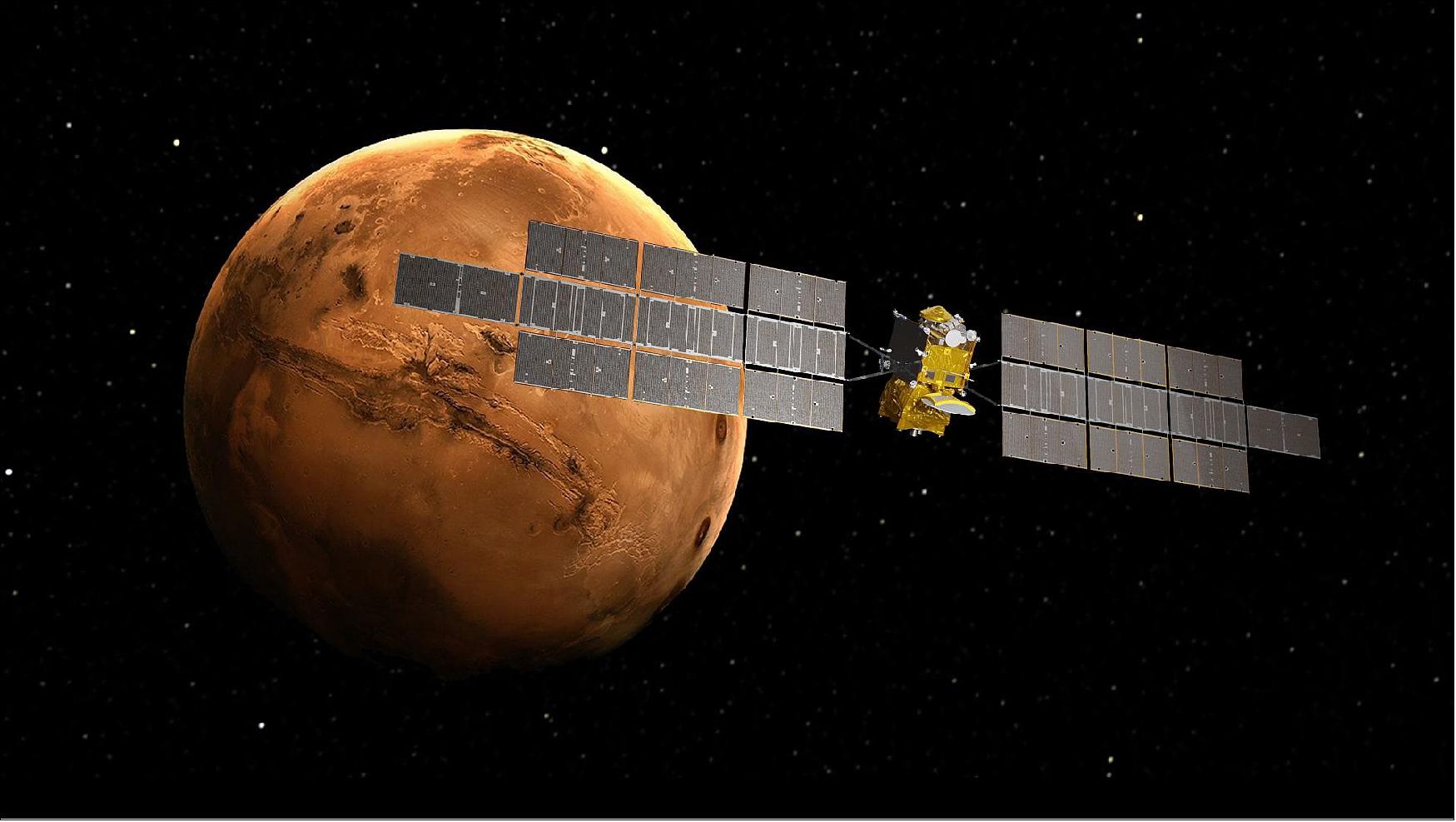
“We’re bringing the full force of our experience gained on Rosetta, Mars Express, Venus Express, Gaia, ATV, BepiColombo, and JUICE to ensure this mission succeeds. Bringing samples back to Earth from Mars will be an extraordinary feat, taking interplanetary science to a new level and Airbus is excited to take on this challenge as part of this joint international mission. ” said Jean-Marc Nasr, Head of Airbus Space Systems.
The 6 ton, 6 m high spacecraft, equipped with 144 m2 solar arrays with a span of over 40 m – some of the biggest ever built – will take about a year to reach Mars. It will use a mass-efficient hybrid propulsion system combining electric propulsion for the cruise and spiral down phases and chemical propulsion for Mars orbit insertion. Upon arrival, it will provide communications coverage for the NASA Perseverance Rover and Sample Retrieval Lander (SRL) missions, two essential parts of the MSR Campaign.
For the second part of its mission, ERO will have to detect, rendezvous with, and capture a basketball-size object called the Orbiting Sample (OS), which houses the sample tubes collected by SFR; all this over 50 million km away from ground control. Once captured, the OS will be bio-sealed in a secondary containment system and placed inside the Earth Entry Vehicle (EEV), effectively a third containment system, to ensure that the precious samples reach the Earth’s surface intact for maximum scientific return. It will then take another year for ERO to make its way back to Earth, where it will send the EEV on a precision trajectory towards a pre-defined landing site, before itself entering into a stable orbit around the Sun.
After landing, the samples will be transferred to a specialized handling facility where they will be quarantined. Once the sample tubes are opened, initial measurements will be taken to generate a detailed catalogue, enabling specific parts of the samples to then be targeted for specialist science investigations.
Airbus will have overall responsibility for the ERO mission, developing the spacecraft in Toulouse, and conducting mission analysis in Stevenage. Thales Alenia Space Turin will also have an important role, assembling the spacecraft, developing the communication system and providing the Orbit Insertion Module. The mission enabling RIT-2X ion engines will be provided by ArianeGroup.
About Mars Sample Return
Mars Sample Return is a set of three separately launched missions, which will together achieve the objective of returning Mars samples to Earth before the end of 2031.
The NASA-led Mars 2020 rover, known as Perseverance, was launched in July 2020 to land on Mars in February 2021. Perseverance will acquire Mars samples, cache them into sample tubes, and leave the tubes in one or more depots for later collection by the SRL (Sample Retrieval Lander) mission and its European Sample Fetch Rover.
The NASA-led SRL comprises a surface platform with a European robotic Sample Transfer Arm (STA), the Sample Fetch Rover (SFR), and a Mars Ascent Vehicle (MAV). The surface platform will land in the near vicinity of the sample tube depot in the Jezero crater. SFR will navigate, locate and collect the sample tubes, and return to the lander platform. The STA will transfer the sample tubes into the Orbiting Sample (OS) then load the OS aboard the MAV. The MAV will launch the OS into Mars orbit, where ERO will be waiting to rendezvous and capture it.
The ESA-led Earth Return Orbiter (ERO) will have onboard the NASA-led Capture, Containment and Return System (CCRS), which will handle and bio-seal the OS as well as provide the Earth Entry Vehicle (EEV). ERO will arrive in Mars orbit on time to provide communications coverage for the SRL entry, descent and landing, surface operations, and the MAV launch placing the OS into Mars orbit. ERO will have to detect, rendezvous with, and capture the OS. The OS will then be bio-sealed and transferred to the EEV before ERO heads back to Earth.
Upon approach to Earth, ERO will release the Earth Entry System on an Earth entry trajectory. After landing in the desert of Utah, the samples are transferred to a sample receiving and curation facility.
Development Status
• July 27, 2022: NASA has finished the system requirements review for its Mars Sample Return Program, which is nearing completion of the conceptual design phase. During this phase, the program team evaluated and refined the architecture to return the scientifically selected samples, which are currently in the collection process by NASA’s Perseverance rover in the Red Planet’s Jezero Crater. 2)
- The architecture for the campaign, which includes contributions from the European Space Agency (ESA), is expected to reduce the complexity of future missions and increase probability of success.
- “The conceptual design phase is when every facet of a mission plan gets put under a microscope,” said Thomas Zurbuchen, associate administrator for science at NASA Headquarters in Washington. “There are some significant and advantageous changes to the plan, which can be directly attributed to Perseverance’s recent successes at Jezero and the amazing performance of our Mars helicopter.”
- This advanced mission architecture takes into consideration a recently updated analysis of Perseverance’s expected longevity. Perseverance will be the primary means of transporting samples to NASA’s Sample Retrieval Lander carrying the Mars Ascent Vehicle and ESA’s Sample Transfer Arm.
- As such, the Mars Sample Return campaign will no longer include the Sample Fetch Rover or its associated second lander. The Sample Retrieval Lander will include two sample recovery helicopters, based on the design of the Ingenuity helicopter, which has performed 29 flights at Mars and survived over a year beyond its original planned lifetime. The helicopters will provide a secondary capability to retrieve samples cached on the surface of Mars.
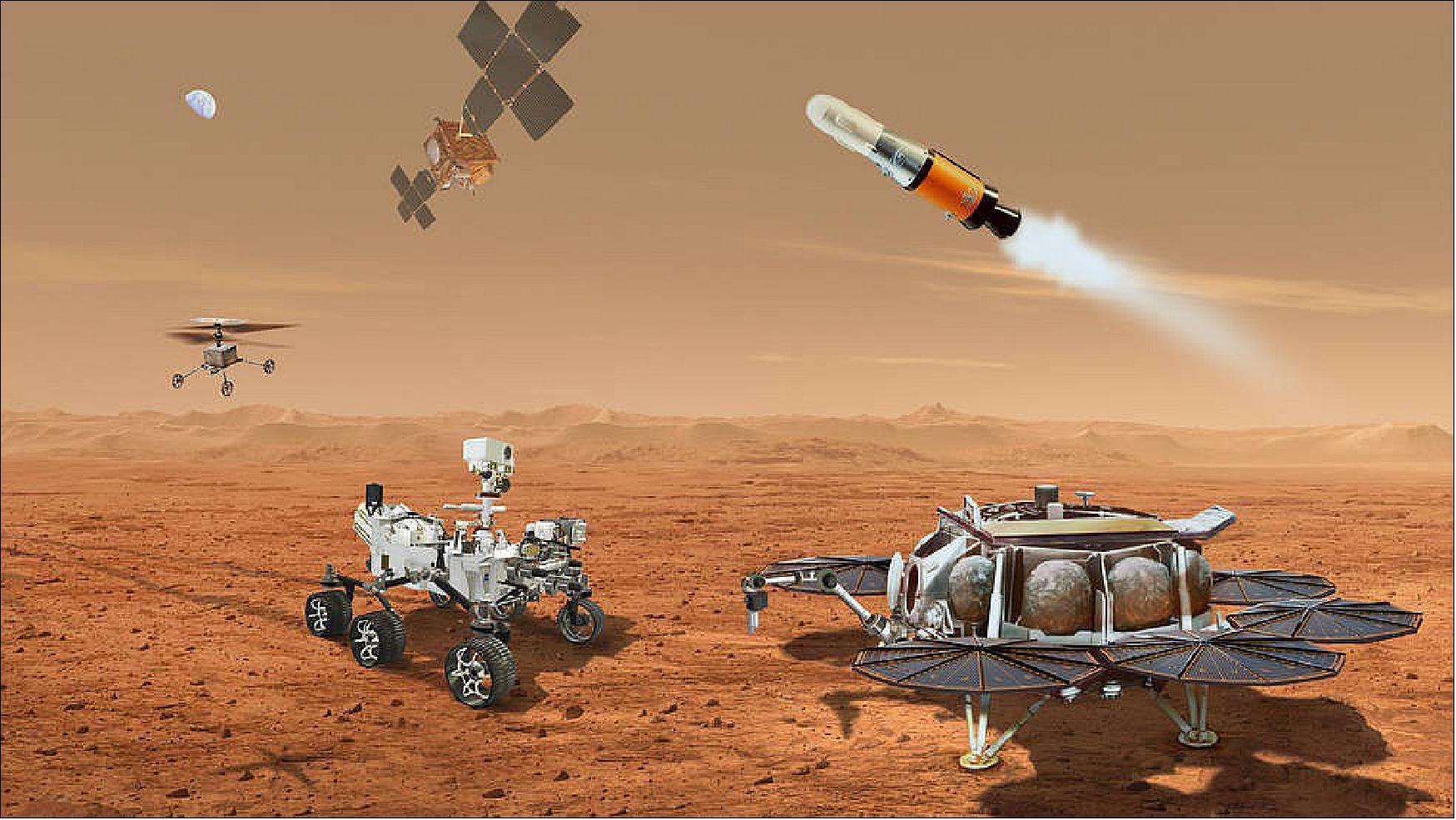
- The ESA Earth Return Orbiter and its NASA-provided Capture, Containment, and Return System remain vital elements of the program architecture.
- With its architecture solidified during this conceptual design phase, the program is expected to move into its preliminary design phase this October. In this phase, expected to last about 12 months, the program will complete technology development and create engineering prototypes of the major mission components.
- This refined concept for the Mars Sample Return campaign was presented to the delegates from the 22 participating states of Europe’s space exploration program, Terrae Novae, in May. At their next meeting in September, the states will consider the discontinuation of the development of the Sample Fetch Rover.
- “ESA is continuing at full speed the development of both the Earth Return Orbiter that will make the historic round-trip from Earth to Mars and back again; and the Sample Transfer Arm that will robotically place the sample tubes aboard the Orbiting Sample Container before its launch from the surface of the Red Planet,” said David Parker, ESA director of Human and Robotic Exploration.
- The respective contributions to the campaign are contingent upon available funding from the U.S. and ESA participating states. More formalized agreements between the two agencies will be established in the next year.
- “Working together on historic endeavors like Mars Sample Return not only provides invaluable data about our place in the universe but brings us closer together right here on Earth,” said Zurbuchen.
- The first step in the Mars Sample Return Campaign is already in progress. Since it landed at Jezero Crater Feb. 18, 2021, the Perseverance rover has collected 11 scientifically-compelling rock core samples and one atmospheric sample.
- Bringing Mars samples to Earth would allow scientists across the world to examine the specimens using sophisticated instruments too large and too complex to send to Mars and would enable future generations to study them. Curating the samples on Earth would also allow the science community to test new theories and models as they are developed, much as the Apollo samples returned from the Moon have done for decades. This strategic NASA and ESA partnership will fulfill a solar system exploration goal, a high priority since the 1970s and in the last three National Academy of Sciences Planetary Science Decadal Surveys.
• December 13, 2021: Testing has already begun on what would be the most sophisticated endeavor ever attempted at the Red Planet: bringing rock and sediment samples from Mars to Earth for closer study. 3)
- The multi-mission Mars Sample Return campaign began when NASA’s Perseverance rover landed on Mars this past February to collect Martian rock samples in search of ancient microscopic life. Out of Perseverance’s 43 sample tubes, four have been filled with rock cores and one with Martian atmosphere. Mars Sample Return seeks to bring select tubes back to Earth, where generations of scientists will be able to study them with powerful lab equipment far too large to send to Mars.
- Getting those samples into terrestrial labs would take a decade and involve European partners and multiple NASA centers. ESA (the European Space Agency) is developing a rover for the effort, with engineers at NASA’s Glenn Research Center in Cleveland, Ohio, designing its wheels. The rover would transfer samples to a lander, being developed at NASA’s Jet Propulsion Laboratory in Southern California, that would use a robotic arm (developed by ESA) to pack the samples into a small rocket, called a Mars Ascent Vehicle, being designed by NASA’s Marshall Space Flight Center in Huntsville, Alabama.
- The rocket would launch from the lander to deliver the sample capsule to an ESA spacecraft orbiting Mars. Inside the orbiter, the capsule would be prepared for delivery to Earth by hardware that a team led by NASA’s Goddard Space Flight Center in Greenbelt, Maryland, is developing. This preparation would include sealing the sample capsule within a clean container to trap any Martian material inside, sterilizing the seal, and placing the sealed container into an Earth-entry capsule before the return trip to Earth.
The Lander
- To develop the lander, as well as the system that would help launch the sample-laden rocket from it, engineers at NASA’s JPL are drawing from a long history of Mars exploration: JPL has led nine successful Mars landings, including rovers and stationary landers. But the Sample Retrieval Lander would be the largest, heaviest spacecraft of its type to ever go to Mars, and the Mars Ascent Vehicle launching from it would be the first rocket ever fired off another planet.
- This is where the testing comes in.
- To carry and launch the Mars Ascent Vehicle, the lander needs to be a sturdy platform, weighing about 5,291 pounds (2,400 kg) – almost twice as heavy as Perseverance, which was lowered to the Martian surface with cables from a rocket-powered jet pack. The Sample Retriever Lander wouldn’t have a jet pack; its legs would have to absorb the impact of touchdown, relying on retrorockets to slow its descent, similar to recent Mars lander missions like InSight and Phoenix.
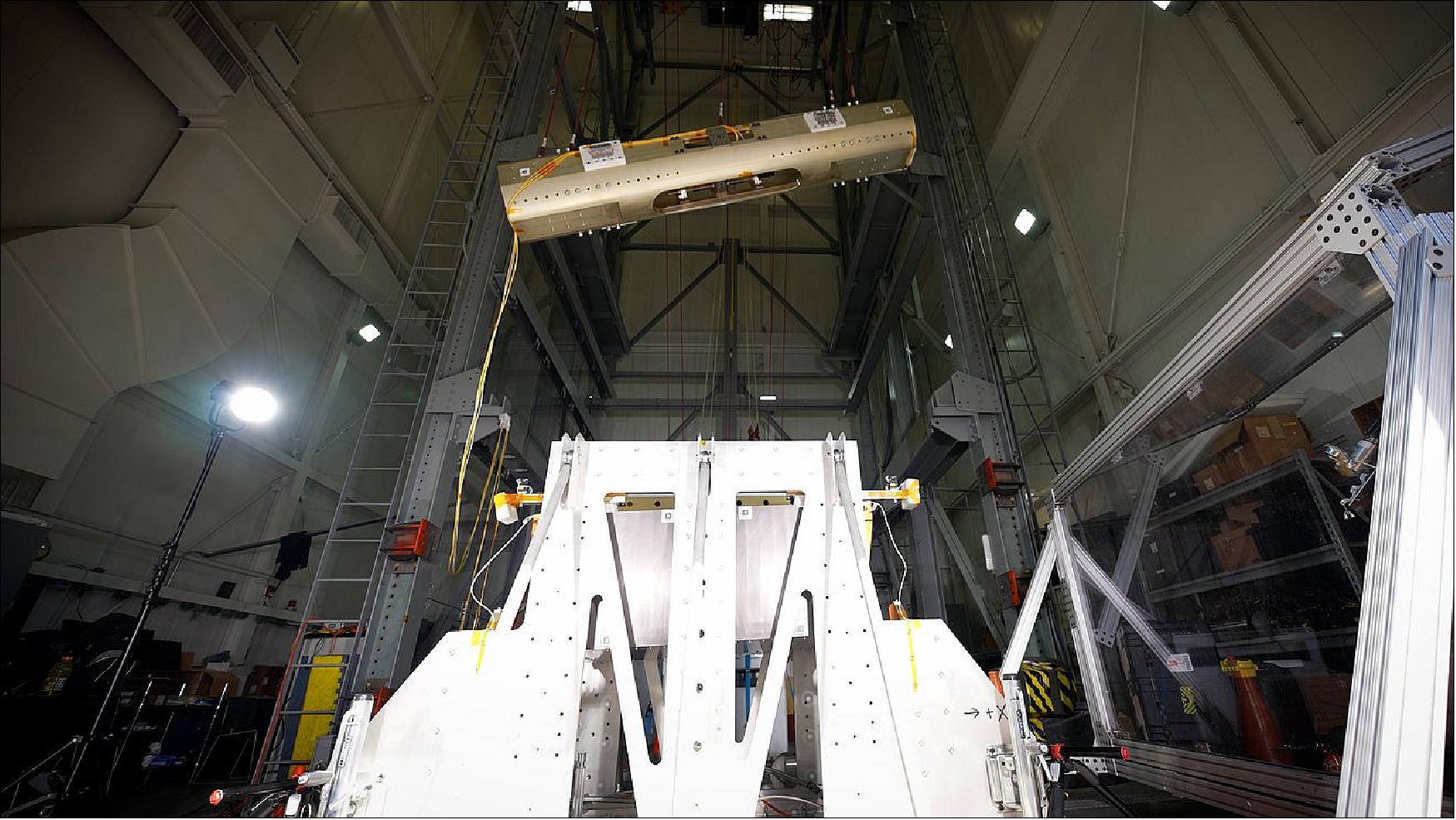
- That’s why Pavlina Karafillis has been dropping a prototype lander – repeatedly – in a warehouse-like space at JPL. As test engineer for the Sample Retrieval Lander’s legs, she and her colleagues have been using high-speed cameras to observe this prototype’s legs slam onto a base. QR-code-like marks on each of the prototype’s “feet” help the cameras track the legs’ motion. The team uses slow-motion video to continually update their computer models, which help them understand how energy would be dispersed throughout the lander.
- “The last step of the journey is really important,” Karafillis said. “There’s all kinds of landing conditions you have to take into account, like rocks, or really soft sand, or coming in at an angle. This is why we have to do all this testing.”
- Karafillis and her colleagues have started with a prototype roughly one-third the size of what the actual spacecraft would be; a lighter prototype is one way to learn how the final lander design would move in Mars’ low gravity. Later in the program, they will drop a full-scale lander, as well.
The Rocket
- Surviving landing is just part of the challenge: Safely launching the nine-foot-long (2.8-meter-long) two-stage rocket that will sit atop the lander’s deck adds another level of difficulty. Mars’ gravity is one-third that of Earth’s, and the rocket’s weight, combined with its exhaust, could cause the lander to slip or tilt.
- So engineers have conceived of a system to toss the rocket into the air just before it ignites. The whole process happens in a finger-snap, tossing the rocket at a rate of 16 feet (5 meters) per second.
- During testing, a cradle equipped with gas-powered pistons flung an 881-pound (400 kg) mock rocket 11 feet (3.3 m) in the air; cables suspended from a tower 44 feet (13 m) high offloaded more than half of the test article’s weight to simulate Martian gravity.
- “It’s kind of like being on a really fast roller coaster when someone hits the breaks,” said Chris Chatellier, the system’s lead engineer at JPL. “There are a lot of safety aspects to consider. Testing happens in a very controlled sequence of events with everyone outside of the building.”
- This system, known as Vertically Ejected Controlled Tip-off Release (VECTOR) system, also adds a slight rotation during launch, which pitches the rocket up and away from the Martian surface.
- “Launching with VECTOR means the lander could be oriented the wrong way on a slope, and we could still pull this off,” Chatellier said.
- Chatellier and his team have conducted 23 tests this year, changing the rocket’s mass and center of gravity along the way. They also added springs to the bottom of their lander stand-in, watching how much “bounce” the launch system created. Next year, they’ll toss a heavier rocket even higher.
- “We’re on the right path,” Chatellier said. “Our analysis and predicted models were very close to what we saw in the tests.”
• March 4, 2021: NASA has awarded the Mars Ascent Propulsion System (MAPS) contract to Northrop Grumman Systems Corporation of Elkton, Maryland, to provide propulsion support and products for spaceflight missions at the agency’s Marshall Space Flight Center in Huntsville, Alabama. Coupled with the successful touchdown of the Mars Perseverance rover, this award moves NASA and ESA (European Space Agency) one step closer to realizing Mars Sample Return (MSR), a highly ambitious planetary exploration program that will build upon decades of science, knowledge, and experience of Mars exploration. 4)
- The cost-plus, fixed-fee contract has a potential mission services value of $60.2 million and a maximum potential value of $84.5 million. Work on MAPS begins immediately with a 14-month base period, followed by two option periods that may be exercised at NASA’s discretion.
- In the next steps of the MSR campaign, NASA and ESA will provide components for a Sample Retrieval Lander mission and an Earth Return Orbiter mission. The Sample Retrieval Lander mission will deliver a Sample Fetch Rover and Mars Ascent Vehicle (MAV) to the surface of Mars. Marshall is responsible for the MSR Program’s MAV element, which is a two-stage vehicle that will be a critical element in supporting MSR to retrieve and return the samples that the Mars 2020 Perseverance rover will collect for return to Earth. The Martian environment will be a significant factor in the design, development, manufacturing, testing, and qualification of two different solid rocket motors with multiple deliveries of each. Through the MAPS contract, Northrop Grumman will provide the propulsion systems for the MAV, as well as other supporting equipment and logistics services.
- Bringing Mars samples back to Earth will allow scientists across the world to examine the specimens using sophisticated instruments too large and too complex to send to Mars, and will allow future generations to study them using technology not yet available. Curating the samples on Earth will allow the science community to test new theories and models as they are developed, much as the Apollo samples returned from the Moon have done for decades.
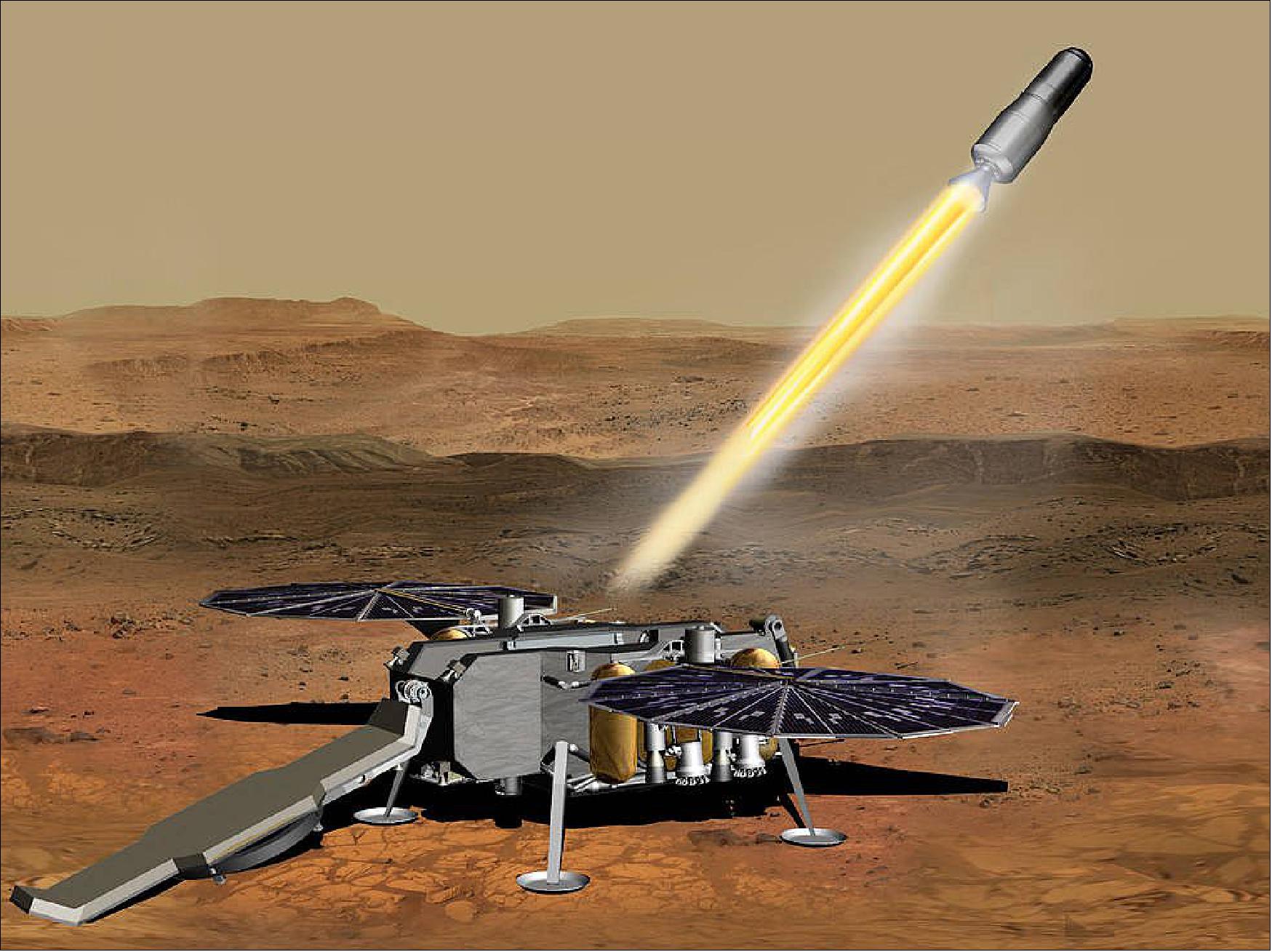
• November 10, 2020: An ambitious campaign by NASA and ESA to collect samples from the Red Planet and return them to Earth has been praised by an Independent Review Board set up to review the multi-year Mars missions. 5)
- The MSR (Mars Sample Return) campaign foresees NASA and ESA launching multiple missions to the Red Planet to collect samples, launch them into space and return them safely to Earth. NASA has released the report of a Mars Sample Return Independent Review Board, which it established to evaluate the status of the multi-year international partnership, together with NASA’s response to its the report’s recommendations.
- The Board, having examined plans for one of the most ambitious endeavors humankind has ever attempted, concluded that the space agencies are ready for the challenge after several decades of scientific advance and technical progress in Mars exploration.
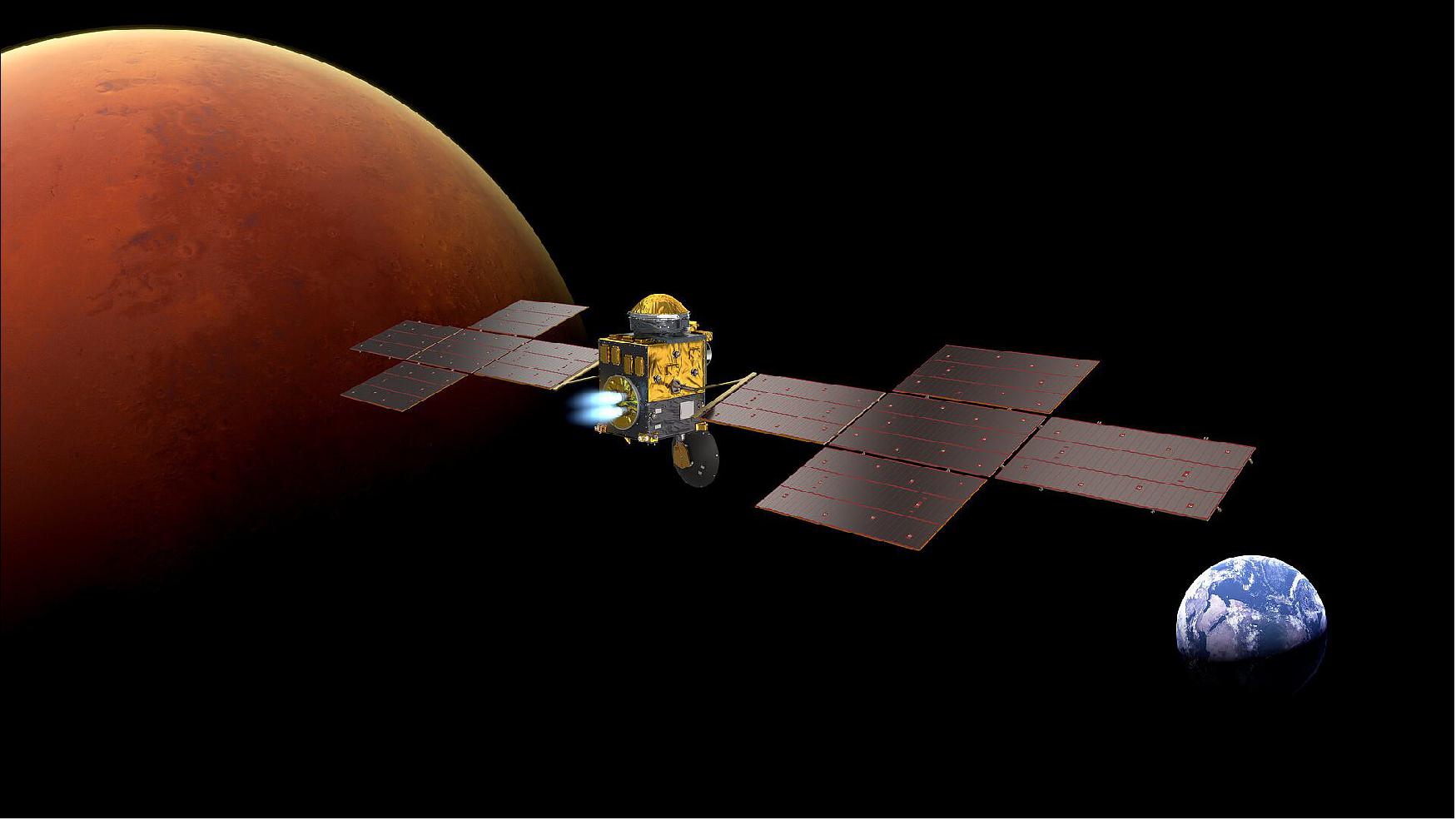
- The Board acknowledged the longstanding cooperation between NASA and ESA in robotic and human space exploration as an asset for the robust campaign and commended the agencies’ work to date.
- “The independent review has given strong support to Mars Sample Return, which is great news for the campaign,” says ESA’s Director of Human and Robotic Exploration, David Parker. “It reinforces our shared vision to provide the world’s scientists with pristine pieces of the Red Planet to study using laboratory tools and techniques that we could never take to Mars.
- “Following on from the International Space Station, Orion and the future Gateway around the Moon, we will strengthen our agencies’ partnership at the frontier of science and technology. ESA will carefully study the report’s recommendations and agree with NASA how to reflect them in our work together.”
Review board
- NASA initiated this Independent Review Board to ensure the long-awaited mission is positioned for success. It is the earliest independent review of any NASA science mission. The Board was comprised of 10 experienced leaders and experts from scientific and engineering fields, and included interviews with experts across NASA and ESA, as well as in industry and academia. The Board made 44 recommendations regarding the program’s scope and management, technical approach, schedule and funding profile.
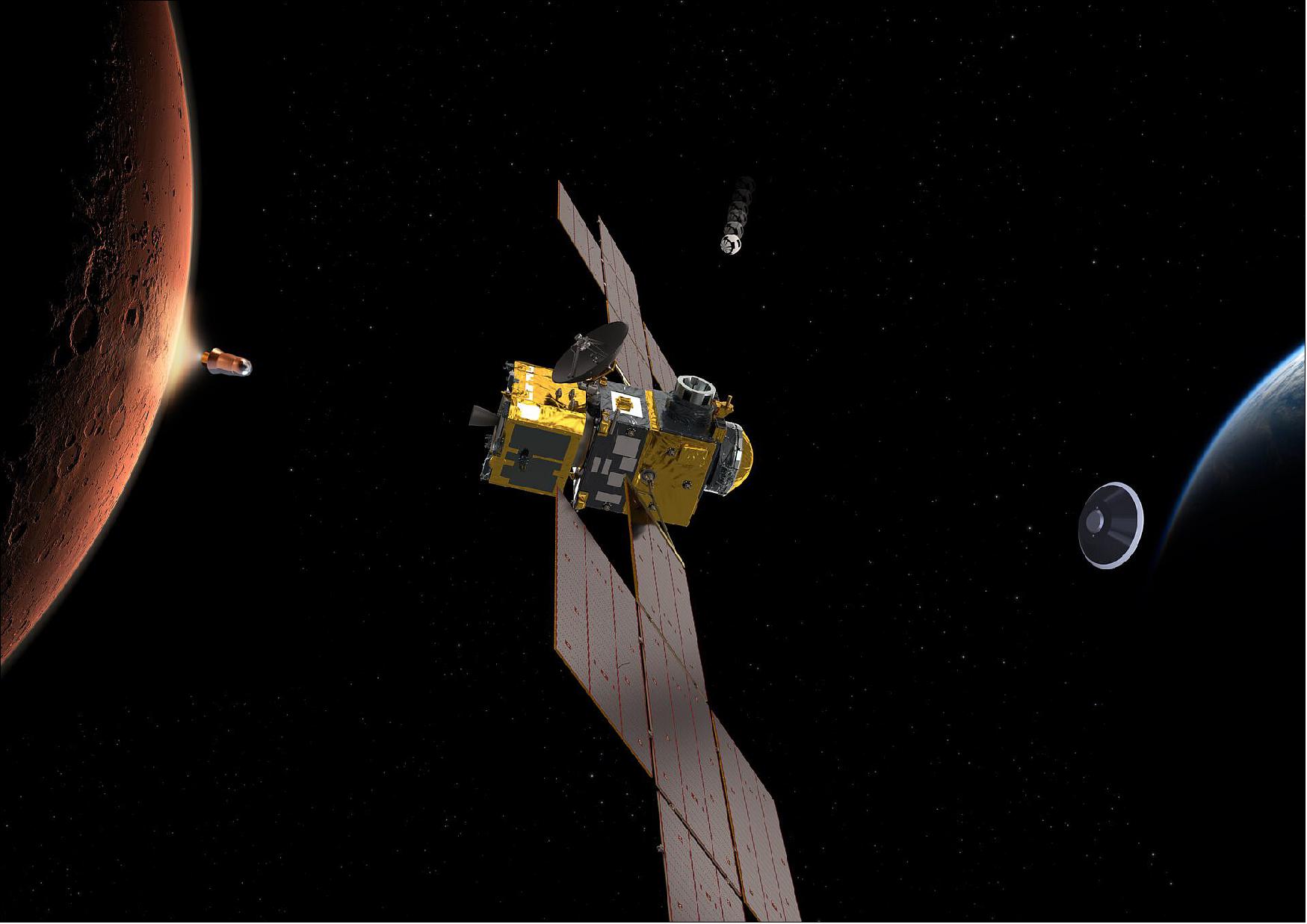
Mars Sample Return
- The campaign will require multiple advanced space vehicles, the first being the NASA Perseverance rover, which is already over halfway to Mars. Perseverance is a sophisticated sampling system, with a coring drill and sample tubes that are among the cleanest hardware ever sent to space.
- Once on Mars, Perseverance will cache rock and soil samples in its collection tubes. It will then leave some of them on the martian surface for ESA’s Sample Fetch Rover to collect and deliver them, using ESA robotic arms, to a NASA Mars Ascent Vehicle, which will launch them into orbit around Mars.
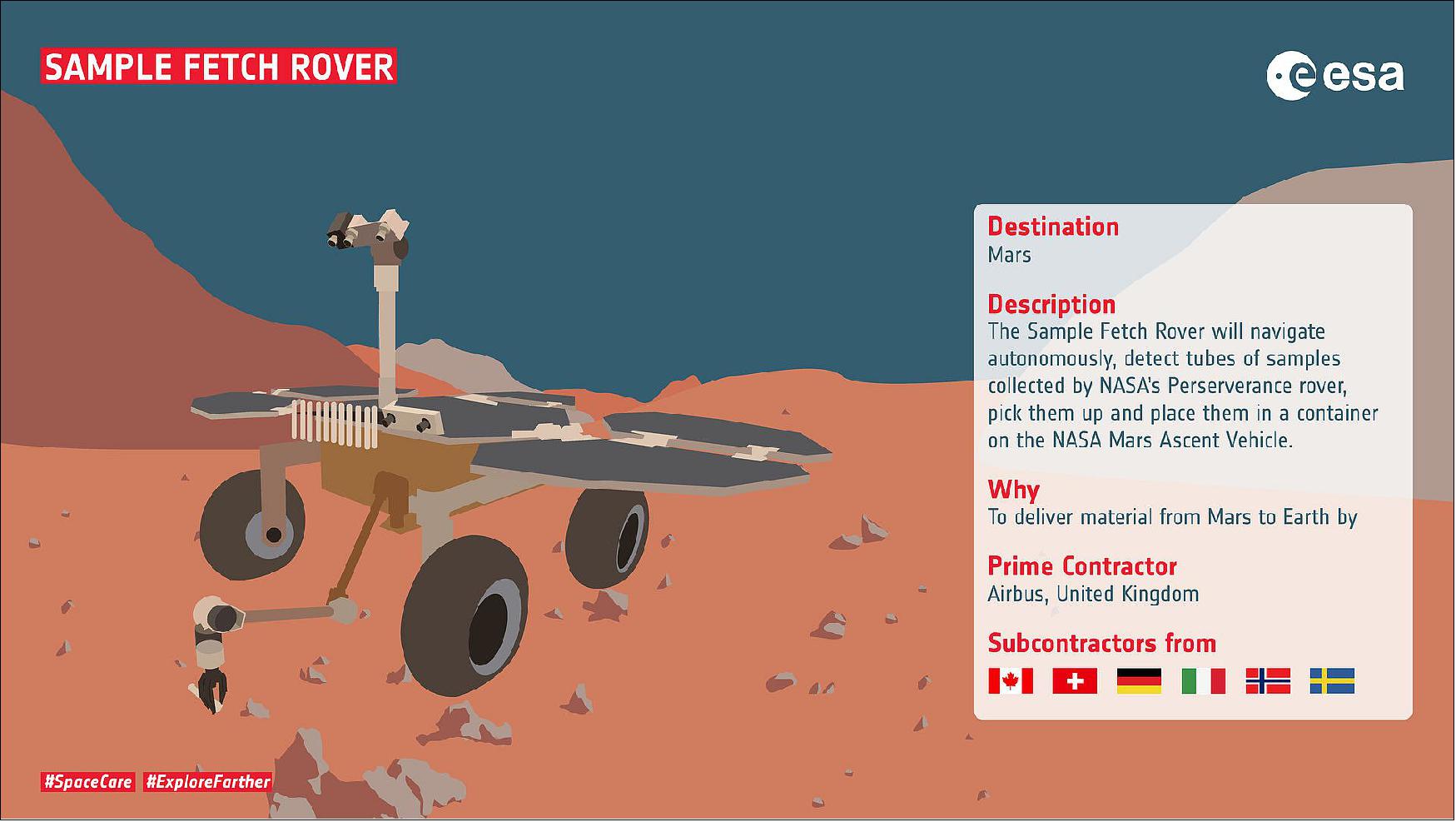
- NASA’s Mars 2020 mission will explore the surface and rigorously document and store a set of samples in canisters in strategic areas to be retrieved later for flight to Earth.
- Two subsequent missions are foreseen to achieve this next step.
- A NASA launch will send the Sample Return Lander mission to land a platform near the Mars 2020 site. From here, a small ESA rover – the Sample Fetch Rover – will head out to retrieve the cached samples.
- Once it has collected them in what can be likened to an interplanetary treasure hunt, it will return to the lander platform and load them into a single large canister on the Mars Ascent Vehicle (MAV). This vehicle will perform the first liftoff from Mars and carry the container into Mars orbit.
- ESA’s Earth Return Orbiter will be the next mission, timed to capture the basketball-size sample container orbiting Mars. The samples will be sealed in a biocontainment system to prevent contaminating Earth with unsterilized material before being moved into an Earth entry capsule.
- The spacecraft will then return to Earth, where it will release the entry capsule for the samples to end up in a specialized handling facility.
• November 10, 2020: NASA released an independent review report Tuesday indicating the agency is well positioned for its Mars Sample Return (MSR) campaign to bring pristine samples from Mars to Earth for scientific study. The agency established the MSR Independent Review Board (IRB) to evaluate its early concepts for a groundbreaking, international partnership with ESA (European Space Agency) to return the first samples from another planet. 6)
- Following an examination of the agency's ambitious Mars Sample Return plan, the board's report concludes that NASA is prepared for the campaign, building on decades of scientific advancements and technical progress in Mars exploration.
- The MSR campaign will require three advanced space vehicles. The first, NASA's Mars 2020 Perseverance rover, is more than halfway to Mars following launch in July. Aboard Perseverance is a sophisticated sampling system with a coring drill and sample tubes that are the cleanest hardware ever sent to space. Once on Mars, Perseverance aims to cache rock and regolith samples in its collection tubes. It then would leave some of them on the Martian surface for an ESA-provided "fetch" rover to collect and deliver to a NASA-provided Mars Ascent Vehicle, which then would launch the samples into orbit around Mars. An ESA-provided Earth Return Orbiter would then rendezvous with the samples in orbit around Mars and take them in a highly secure containment capsule for return to Earth in the 2030s.
- "Mars Sample Return is something NASA needs to do as a leading member of the global community," said NASA Administrator Jim Bridenstine. "We know there are challenges ahead, but that's why we look closely at these architectures. And that's why in the end, we achieve the big accomplishments."
- Sample return is a top priority of the National Academies' Planetary Science Decadal Survey for 2013-2022, and NASA has worked to mature the critical capabilities and overall MSR concept for the past three years. The board acknowledged the longstanding cooperation between NASA and ESA in robotic and human space exploration as an asset for the robust campaign and commended both agencies' early and in-depth analysis of MSR implementation approaches to inform future planning and development.
- "NASA is committed to mission success and taking on great challenges for the benefit of humanity, and one way we do that is by ensuring we are set up to succeed as early as possible," said Thomas Zurbuchen, NASA associate administrator for science at the agency's headquarters in Washington. "I thank the members of this board for their many hours of work resulting in a very thorough review. We look forward to continued planning and mission formulation in close partnership with ESA. Ultimately, I believe this sample return will be well worth the effort - bringing us one step closer to our eventual goal of sending humans to Mars."
- NASA initiated the IRB in mid-August to ensure the long-awaited mission is positioned for success. It is the earliest independent review of any NASA Science Mission Directorate large strategic mission. Historically, such reviews have not occurred until much later in the program development.
- David Thompson, retired president and CEO of Orbital ATK, chaired the IRB, which comprised 10 experienced leaders from scientific and engineering fields. The board, which met during 25 sessions from August to October of this year, interviewed experts across NASA and ESA, as well as in industry and academia, and made 44 recommendations to address potential areas of concern regarding the program's scope and management, technical approach, schedule, and funding profile.
- "The MSR campaign is a highly ambitious, technically demanding, and multifaceted planetary exploration program with extraordinary scientific potential for world-changing discoveries," said Thompson. "After a thorough review of the agency's planning over the past several years, the IRB unanimously believes that NASA is now ready to carry out the MSR program, the next step for robotic exploration of Mars."
- The IRB found that NASA has developed a feasible concept and a broad set of architectural options to inform the planning of the MSR campaign over the next several years and recommends the MSR program proceed. It also highlighted the excellent progress the agency has achieved over the past several years and further emphasized the potential for this program to enable civilization-scale scientific discoveries underscoring that the technology is available now.
- "The independent review has given strong support to MSR, which is great news for the campaign," says ESA's Director of Human and Robotic Exploration, David Parker. "It reinforces our shared vision to provide the world's scientists with pristine pieces of the Red Planet to study using laboratory tools and techniques that we could never take to Mars."
- The IRB provided its findings and recommendations to NASA for consideration to better position the program for success. NASA has agreed to address and study all of the board's recommendations in the next year as it moves through early formulation efforts, well in advance of the agency's confirmation decision.
References
1) ”Airbus to bring first Mars samples to Earth: ESA contract award,” Airbus, 14 October 2020, URL: https://web.archive.org/web/20211019111810/https://www.airbus.com/newsroom/press-releases/en/2020/10/airbus-to-bring-first-mars-samples-to-earth-esa-contract-award.html
2) Dewayne Washington, DC Agle, ”NASA Will Inspire World When It Returns Mars Samples to Earth in 2033,” NASA Press Release 22-078, 27 July 2022, URL: https://www.nasa.gov/press-release/nasa-will-inspire-world-when-it-returns-mars-samples-to-earth-in-2033
3) ”NASA Begins Testing Robotics to Bring First Samples Back From Mars,” NASA/JPL, 13 December 2021, URL: https://www.jpl.nasa.gov/news/nasa-begins-testing-robotics-to-bring-first-samples-back-from-mars?utm_source=iContact&utm_medium=email&utm_campaign=nasajpl&utm_content=mars20211213-1
4) ”NASA Awards Mars Ascent Propulsion System Contract for Sample Return,” NASA Press Release 21-026, 4 March 2021, URL: https://www.nasa.gov/press-release/nasa-awards-mars-ascent-propulsion-system-contract-for-sample-return
5) ”ESA welcomes positive review of plan to bring Mars to Earth,” ESA Science & Exploration, 10 November 2020, URL: https://www.esa.int/Science_Exploration/Human_and_Robotic_Exploration/Exploration/ESA_welcomes_positive_review_of_plan_to_bring_Mars_to_Earth
6) ”Independent Review Indicates NASA Prepared for Mars Sample Return Campaign,” NASA/JPL News, 10 November 2020, URL: https://www.jpl.nasa.gov/news/news.php?release=2020-213
The information compiled and edited in this article was provided by Herbert J. Kramer from his documentation of: ”Observation of the Earth and Its Environment: Survey of Missions and Sensors” (Springer Verlag) as well as many other sources after the publication of the 4th edition in 2002.